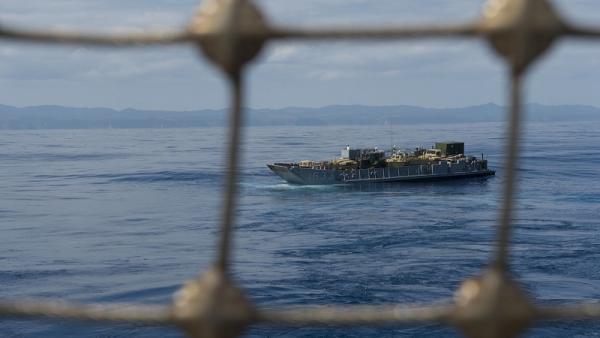Flickr

Elena Collinson, Senior Project and Research Officer, Australia-China Relations Institute, University of Technology Sydney |
This article appeared in the Australian Institute of International Affairs’ blog, Australian Outlook, on July 25 2019.
ASEAN member states and China will meet on 27 July to continue negotiations on the implementation of the Declaration on the Conduct of Parties in the South China Sea (DOC).
The DOC was signed in 2002 and progress since then has been measured in millimetres. A substantive breakthrough was only achieved 16 years on, when in August last year ASEAN and China announced that they had reached agreement on a single draft negotiating text for a code of conduct, finally moving discussions beyond the preliminary consultative phase. Chinese Foreign Minister Wang Yi exulted afterwards that it was “like China and ASEAN countries building a house together.”
Until recently, China had seemed to employ a foot-dragging strategy to delay any agreement on an ASEAN-China Code of Conduct (COC) in the South China Sea. This had been implemented both directly, and indirectly through its influence over some ASEAN member countries (notably Cambodia and Laos) which has exacerbated divisions within ASEAN. Cambodia — which, it is recently claimed, has signed a secret deal to allow China’s military to be stationed at its Ream naval base — has been seen to have acted as a proxy for China’s position on the South China Sea in ASEAN. Laos has also been generally supportive of the Chinese position. Since ASEAN can only come to a decision by consensus, a united ASEAN stance on the South China Sea issue has been elusive. This means that any compromise position has necessarily been watered down and is weak and largely ineffective.
Now there appears to have been a switch in China’s tack from nominal support for a COC to public enthusiasm for it. In November 2018, for example, Chinese Premier Li Keqiang told an audience in Singapore that Beijing hoped to finalise a COC by 2021, telegraphing a notional commitment by China to a schedule.
But a greater display of support for the COC has not restrained China from continuing in earnest its expansionist agenda in the South China Sea, having created 3,200 acres of new land in the Spratlys since 2013. There have also been increasing reports recently of aggressive behaviour by Chinese vessels in the disputed waters, including interference with oil and gas exploration and fishing activities conducted by other claimant states. So too reports on its military muscle-flexing: just earlier this month, China purportedly tested anti-ship ballistic missiles for the first time, thought to be DF-21D “aircraft carrier killers,” in the South China Sea.
The shift in China’s appetite for a COC might therefore be explained by the fact that China is now negotiating from a position of greater strength than previously. Not only has it effectively secured and militarised swathes of the disputed waters but in recent years it has also been engaging in an intensive campaign of bilateral negotiations with claimant nations. Particularly successful has been rapprochement with the Philippines, previously one of the most vocal opponents of China’s assertiveness in the South China Sea. The three-year timeframe in which to conclude a COC nominated by China dovetails in with the Philippines co-chairing the ASEAN-China Dialogue. As such it will lead related meetings, notably the Senior Officials Meetings (SOM) which directly oversees the ASEAN-China Joint Working Group on the Implementation of the Declaration on the Conduct of Parties in the South China Sea.
In addition, agreeing on a document with the parties actually involved in the territorial dispute potentially reduces the scope for American involvement in the matter.
This is not to say that a COC will be concluded if China deems the compromises it might have to make anathema to its interests, especially in sensitive areas such as dispute settlement mechanisms and the role third parties not signatory to the COC might play. But being able to finalise the document might enhance the new strategic reality that China seems to be coaxing along in the region, and imbue the country with greater credibility as a rules-maker.
China’s actions in the South China Sea, and its recalcitrance in the face of criticism of its assertiveness and in some cases aggression, have highlighted clearly its dissatisfaction with the current interpretation of the oft-cited “rules-based order,” at least as it pertains to this particular sphere. This is seen for example in its outright rejection of the adverse ruling on its claims over the waters by an international arbitral tribunal in 2016. Vice Foreign Minister Lu Zhenmin dismissed the ruling at the time as “nothing more than a piece of waste paper.”
There is nonetheless a need for caution in extrapolating China’s actions and efforts in this sphere to all aspects of the rules-based order as it currently stands, for many aspects of this order serve Chinese interests and, as such, China is supportive of them. As Columbia University Professor Andrew J Nathan observes, “Chinese behaviour in international regimes does not show a pattern of promoting a distinctive “Chinese model” or an alternative vision of the world order.”
But while China has not necessarily indicated an overt desire to engage in a wholesale overhaul of this order, it is plain that it seeks to align it far more closely to its interests. Shaping consensus on a COC in the South China Sea would contribute to this objective.
Author
Elena Collinson is a senior researcher at the Australia-China Relations Institute, University of Technology Sydney.


